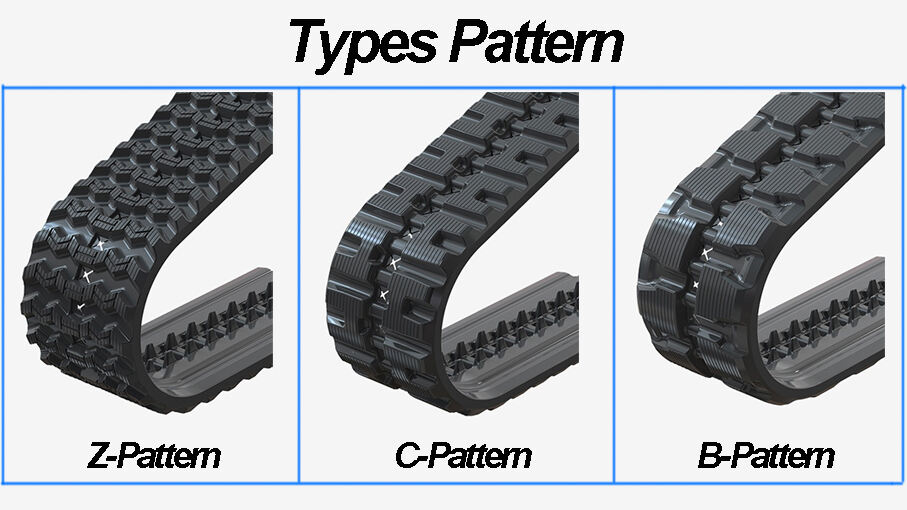Terrain Suitability: Rubber Tracks vs Steel Tracks for Different Environments
Rubber Track Performance on Paved Surfaces and Landscapes
Rubber track are excellent for urban and landscape protection. Their flexible construction changes the tire contact area on the ground by as much as 40% compared to steel versions, in turns minimizing the damage to asphalt, concrete and turf. A 2024 Construction Equipment Survey reported that rubber track systems decrease surface damage occurrences by 68% on highways. The natural vibration damping makes them great in noise sensitive areas such as residential and indoor facilities.
Steel Track Dominance in Rocky and Rugged Terrains
Steel tracks are superior in heavy duty work conditions such as harsh terrains with obstructions, such as jagged edges or steep elevations. Their infighting metal plates are capable of withstanding pressures exceeding 1,200 PSI three times that of even premium rubber tracks in abrasive conditions. Miners, foresters are also reporting productivity improvements in the 20 – 30% range when using steel tracks on rock grades due to better traction and a lower risk of slipping.
Hybrid Solutions for Mixed-Environment Operations
For projects transitioning between terrain types, hybrid track systems combine steel-reinforced rubber cores with replaceable outer pads. Contractors managing multi-phase projects (e.g., urban roadwork transitioning to rural earthmoving) benefit from quick-swap track assemblies, which cut equipment downtime by 33% compared to single-track systems.
Material Durability Comparison: Rubber vs Steel Tracks
Wear Resistance in Extreme Weather Conditions
Steel tracks maintain structural integrity in temperatures ranging from -40°F to 120°F due to alloy enhancements. Rubber hardens in freezing conditions, increasing crack risks, and softens in heat above 90°F, accelerating tread wear. A 2023 field study found steel tracks had 80% fewer weather-related failures than rubber in extreme environments.
Impact of Jobsite Debris on Track Longevity
Steel’s layered plating resists punctures from rebar, rocks, and demolition waste, with only 12% of mining operators reporting debris-related replacements annually. Rubber tracks show a 63% higher incidence of cuts in recycling plants and forestry operations.
Average Lifespan Expectations for Both Track Types
Steel’s lifespan superiority comes at a cost: regular lubrication and rust prevention add 15% to maintenance budgets. Rubber’s shorter operational life is offset by lower upfront costs and minimal upkeep.
Cost Analysis: Rubber Tracks vs Steel Tracks for Mini Excavators
Initial Purchase Price Differences
Rubber tracks typically cost 30–50% less upfront than steel tracks, making them attractive for short-term projects. Steel variants command a premium due to reinforced construction, with prices often exceeding $10,000 per set compared to $6,000–$7,000 for rubber.
Long-Term Maintenance and Replacement Costs
Rubber tracks require 2–3 times more frequent replacements on abrasive surfaces, costing $1,500–$3,000 per replacement. Steel tracks last nearly double rubber’s lifespan but require weekly lubrication, adding $200–$500 annually in upkeep.
Cost-Effectiveness Across Project Durations
For projects under 6 months, rubber tracks often prove more economical. Contractors handling 2+ year infrastructure projects benefit from steel tracks’ longevity.
Surface Protection and Operational Impact
Rubber Track Advantages in Sensitive Urban Areas
Rubber tracks reduce point pressure on concrete and asphalt by up to 38%, minimizing cracks in sidewalks and pavements. Their noise levels also comply with urban ordinances.
Steel Track Consequences for Asphalt and Turf
Steel-tracked excavators create deeper grooves in asphalt and disrupt turf, requiring costly repairs. A 2022 study linked steel tracks to a 45% increase in urban pavement repair costs.
Vibration Transfer and Subsurface Damage Risks
Steel tracks transmit 20–30% more ground vibration, posing risks to buried utilities. Rubber absorbs 60–70% of vibrations, making it safer near gas lines and historic structures.
Noise and Vibration Levels: Rubber vs Steel Tracks
Operator Comfort Comparison
Rubber tracks reduce operator fatigue by up to 40%, while steel transmits shocks directly through the chassis. 72% of operators prefer rubber for tasks exceeding 4 hours.
Compliance with Urban Noise Regulations
Rubber tracks (50-60 dB) stay below urban noise thresholds. Steel tracks exceed 85 dB, risking fines in noise-sensitive zones.
Application-Specific Recommendations
Optimal Uses in Landscaping and Municipal Work
Rubber tracks protect turf and paved surfaces while meeting noise regulations. Urban operators favor them for their reduced vibration transfer.
Steel Track Requirements for Mining and Forestry
Steel tracks endure jagged rocks and steep inclines, lasting 10,000 hours in abrasive conditions despite higher maintenance needs.
FAQ
What are the main advantages of rubber tracks?
Rubber tracks are excellent for urban and landscape protection, reducing surface damage, offering vibration damping, and complying with noise-sensitive areas.
In what conditions do steel tracks perform best?
Steel tracks are best suited for heavy-duty work in harsh terrains with obstacles, where they provide superior traction and durability.
How do hybrid tracks benefit multi-terrain projects?
Hybrid tracks combine the benefits of steel and rubber, allowing for quick swaps between terrains and reducing equipment downtime.
How does extreme weather affect both track types?
Steel tracks maintain performance across a wide temperature range, while rubber tracks are prone to hardening in cold and softening in heat.
Which track type is more economical for long-term use?
Steel tracks, despite higher initial and maintenance costs, are generally more economical for projects exceeding two years due to their durability.
Table of Contents
- Terrain Suitability: Rubber Tracks vs Steel Tracks for Different Environments
- Material Durability Comparison: Rubber vs Steel Tracks
- Cost Analysis: Rubber Tracks vs Steel Tracks for Mini Excavators
- Surface Protection and Operational Impact
- Noise and Vibration Levels: Rubber vs Steel Tracks
- Application-Specific Recommendations
- FAQ




